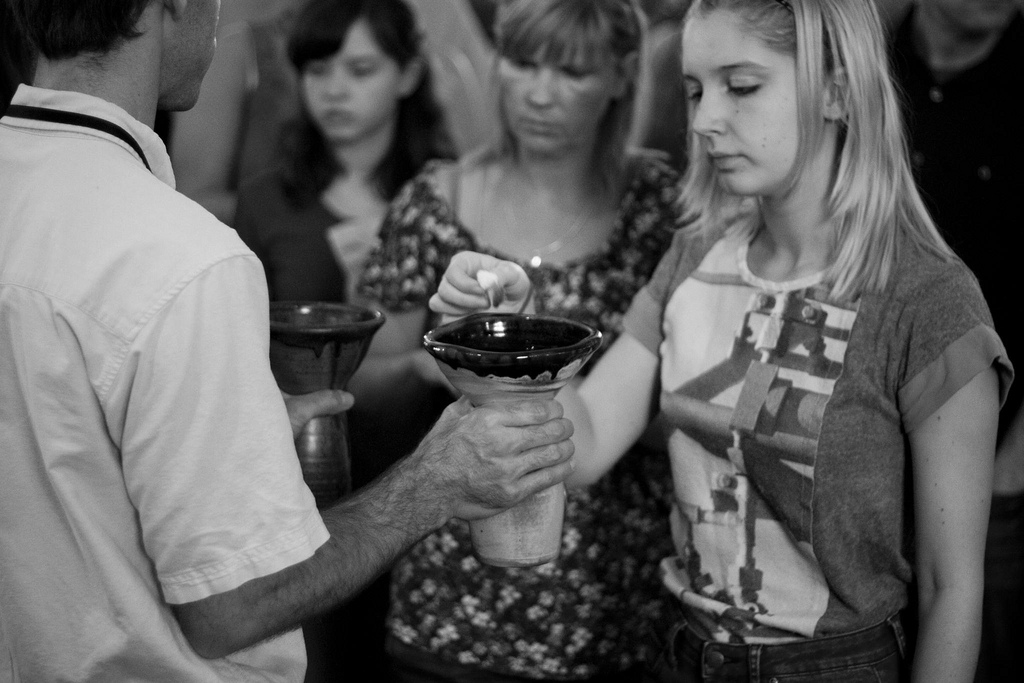 At our church Sojourn, we take the Lord’s Supper standing up, filing forward in lines as the worship band plays a communion hymn. In turn, each Christian tears off a piece of bread while the volunteer holding the bread recites “The body of Jesus, broken for you.”
At our church Sojourn, we take the Lord’s Supper standing up, filing forward in lines as the worship band plays a communion hymn. In turn, each Christian tears off a piece of bread while the volunteer holding the bread recites “The body of Jesus, broken for you.”
Then the Christian dips his bread in one of two cups that another volunteer holds, one filled with wine and one filled with juice (each person chooses one or the other, as his or her conscience permits). While the Christian dips his bread in the cup, the volunteer says “The blood of Jesus, shed for you.”
We like the symbolism portrayed in the common cup, and in each Christian actively leaving their seat to come forward. But of course this isn’t the only “right” way to do communion. The important thing is for pastors and worship leaders to think through it and to know why you do it the way you do it.
The volunteers are church members. Most often, we pair up teams of men and women (husband and wife serving together, in the case of married volunteers), so that one holds the bread and one holds the cups.
Here are some good thoughts about the two most common ways of doing communion, from The Work Of The People: What We Do in Worship and Why, by Marlea Gilbert, Christopher Grundy, Eric T. Myers and Stephanie Perdew.
Regarding The Shared Communion Cup:
“A shared common cup has a long history and origins in early Christian practice. Even more important, a common cup allows us to enact our unity in Christ; we share the same cup, the same covenant, and the same blessing. Whether we drink from a common cup (which is the practice in many churches, and which carries minimal health risk if wine is used) or use instinction (the act of dipping a piece of bread in the cup), we physically demonstrate our participation in that common blessing, just as tearing a piece of bread from a common loaf demonstrates our participation in the one body of Christ.”
Regarding Individual Communion Cups:
“Many of us have received miniature, single-sip cups and small squares of bread passed in trays in our pews or distributed at a communion rail. This practice does have its own positive symbolic values. The bread and cup come to us where we are, just as God’s grace does. Passing trays along the pews allows us to serve one another, rather than receiving only from those who are chosen to lead. Still, this practice has often allowed us to slide toward passivity. We have often come to see ourselves as recipients waiting to be served, rather than as people who gather to eat and rejoice together. Even when we have all waited to eat and drink the elements at the same moment, our individual servings have tended to drive us toward private piety, toward personal time with God, rather than toward the communal experience of God’s presence among us that is so crucial for corporate worship.”
What do you think?
Communion photo by Troy Harvey, from Sojourn’s East campus
{ 3 comments }
Great post bobby. I’m working on an article about how churches should have 3-4 different ways they celebrate communion to effectively reflect all the biblical imagery connected to communion, lord’s supper, lambs feast, etc.
Thanks Bruce. Can’t wait to read your post!
My Dad’s church does the communion cup and wafer thing. But after the elements have been taken there is a twist. Everyone in the congregation joins hands and sings Bless Be The Tie. So it ends up in a communal sense. It might be nice to try this at Sojourn sometime. It seems it would go just a bit further to break down barriers.